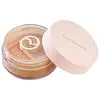NARS Cosmetics Radiant Creamy Concealer Versus Rare Beauty Always an Optimist Soft Radiance Setting Powder
What's inside
What's inside
 Key Ingredients
Key Ingredients

 Benefits
Benefits

 Concerns
Concerns

 Ingredients Side-by-side
Ingredients Side-by-side

Water
Skin ConditioningDimethicone
EmollientHydrogenated Polydecene
EmollientPropanediol
SolventButylene Glycol
HumectantPEG-9 Polydimethylsiloxyethyl Dimethicone
EmulsifyingGlycerin
HumectantDisteardimonium Hectorite
StabilisingPEG-10 Dimethicone
Skin ConditioningPolymethyl Methacrylate
Bis-Butyldimethicone Polyglyceryl-3
CleansingSorbitan Sesquiisostearate
EmulsifyingDimethicone/Vinyl Dimethicone Crosspolymer
Skin ConditioningPhenoxyethanol
PreservativeIsostearic Acid
CleansingPolysilicone-2
Aluminum Hydroxide
EmollientMaltodextrin
AbsorbentTrisodium EDTA
Lecithin
EmollientSilica
AbrasiveTin Oxide
AbrasiveTriethoxycaprylylsilane
Tocopheryl Acetate
AntioxidantSodium Metabisulfite
AntioxidantMagnolia Officinalis Bark Extract
AntimicrobialTocopherol
AntioxidantVitis Vinifera Seed Extract
AntimicrobialMica
Cosmetic ColorantCI 77891
Cosmetic ColorantCI 77491
Cosmetic ColorantCI 77492
Cosmetic ColorantCI 77499
Cosmetic ColorantCI 77163
Cosmetic ColorantCI 42090
Cosmetic ColorantWater, Dimethicone, Hydrogenated Polydecene, Propanediol, Butylene Glycol, PEG-9 Polydimethylsiloxyethyl Dimethicone, Glycerin, Disteardimonium Hectorite, PEG-10 Dimethicone, Polymethyl Methacrylate, Bis-Butyldimethicone Polyglyceryl-3, Sorbitan Sesquiisostearate, Dimethicone/Vinyl Dimethicone Crosspolymer, Phenoxyethanol, Isostearic Acid, Polysilicone-2, Aluminum Hydroxide, Maltodextrin, Trisodium EDTA, Lecithin, Silica, Tin Oxide, Triethoxycaprylylsilane, Tocopheryl Acetate, Sodium Metabisulfite, Magnolia Officinalis Bark Extract, Tocopherol, Vitis Vinifera Seed Extract, Mica, CI 77891, CI 77491, CI 77492, CI 77499, CI 77163, CI 42090
Mica
Cosmetic ColorantSilica
AbrasiveCI 77220
Cosmetic ColorantC12-15 Alkyl Benzoate
AntimicrobialMagnesium Myristate
Nylon-12
1,2-Hexanediol
Skin ConditioningCaprylic/Capric Triglyceride
MaskingCaprylyl Glycol
EmollientCoco-Caprylate/Caprate
EmollientEthylhexylglycerin
Skin ConditioningMagnesium Stearate
Cosmetic ColorantPolymethylsilsesquioxane
Squalane
EmollientTocopherol
AntioxidantTocopheryl Acetate
AntioxidantPhenoxyethanol
PreservativeCI 19140
Cosmetic ColorantIron Oxides
Mica, Silica, CI 77220, C12-15 Alkyl Benzoate, Magnesium Myristate, Nylon-12, 1,2-Hexanediol, Caprylic/Capric Triglyceride, Caprylyl Glycol, Coco-Caprylate/Caprate, Ethylhexylglycerin, Magnesium Stearate, Polymethylsilsesquioxane, Squalane, Tocopherol, Tocopheryl Acetate, Phenoxyethanol, CI 19140, Iron Oxides
 Reviews
Reviews

Ingredients Explained
These ingredients are found in both products.
Ingredients higher up in an ingredient list are typically present in a larger amount.
Mica is a naturally occurring mineral used to add shimmer and color in cosmetics. It can also help improve the texture of a product or give it an opaque, white/silver color.
Serecite is the name for very fine but ragged grains of mica.
This ingredient is often coated with metal oxides like titanium dioxide. Trace amounts of heavy metals may be found in mica, but these metals are not harmful in our personal products.
Mica has been used since prehistoric times throughout the world. Ancient Egyptian, Indian, Greek, Roman, Aztec, and Chinese civilizations have used mica.
Learn more about MicaPhenoxyethanol is a preservative that has germicide, antimicrobial, and aromatic properties. Studies show that phenoxyethanol can prevent microbial growth. By itself, it has a scent that is similar to that of a rose.
It's often used in formulations along with Caprylyl Glycol to preserve the shelf life of products.
Silica, also known as silicon dioxide, is a naturally occurring mineral. It is used as a fine, spherical, and porous powder in cosmetics.
Though it has exfoliant properties, the function of silica varies depending on the product.
The unique structure of silica enhances the spreadability and adds smoothness, making it a great texture enhancer.
It is also used as an active carrier, emulsifier, and mattifier due to its ability to absorb excess oil.
In some products, tiny microneedles called spicules are made from silica or hydrolyzed sponge. When you rub them in, they lightly polish away dead skin layers and enhance the penetration of active ingredients.
Learn more about SilicaTocopherol (also known as Vitamin E) is a common antioxidant used to help protect the skin from free-radicals and strengthen the skin barrier. It's also fat soluble - this means our skin is great at absorbing it.
Vitamin E also helps keep your natural skin lipids healthy. Your lipid skin barrier naturally consists of lipids, ceramides, and fatty acids. Vitamin E offers extra protection for your skin’s lipid barrier, keeping your skin healthy and nourished.
Another benefit is a bit of UV protection. Vitamin E helps reduce the damage caused by UVB rays. (It should not replace your sunscreen). Combining it with Vitamin C can decrease sunburned cells and hyperpigmentation after UV exposure.
You might have noticed Vitamin E + C often paired together. This is because it is great at stabilizing Vitamin C. Using the two together helps increase the effectiveness of both ingredients.
There are often claims that Vitamin E can reduce/prevent scarring, but these claims haven't been confirmed by scientific research.
Learn more about TocopherolTocopheryl Acetate is AKA Vitamin E. It is an antioxidant and protects your skin from free radicals. Free radicals damage the skin by breaking down collagen.
One study found using Tocopheryl Acetate with Vitamin C decreased the number of sunburned cells.
Tocopheryl Acetate is commonly found in both skincare and dietary supplements.
Learn more about Tocopheryl Acetate